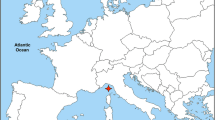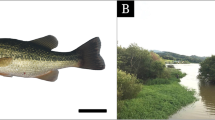Summary
Light and electron microscopic observations on the ampullary organs of Polyodon spathula (Chondrostei, Osteichthyes) reveal a sensory epithelium similar to that found in the Lorenzinian ampulla, an electroreceptor found in marine Elasmobranchs.
The sensory cells have a very small luminal part provided with a cilium. They are innervated by many nerve endings. Each nerve fibre apparently makes synaptic contact with several sensory cells. The synaptic structure in the sensory cell is composed of a flat sheet, the outermost part of which is surrounded by 3 or 4 annuli of densely staining material. The sheet extends into a protrusion of the sensory cell, and there is a corresponding invagination in the nerve terminal.
The conclusion that these organs are electroreceptors, is supported by the finding that the fish responds to the introduction of an iron tube in the aquarium, whereas a wooden rod introduced in the same way causes no response.
Similar content being viewed by others
References
Barets, A., Szabo, T.: Appareil synaptique des cellules sensorielles de l'ampoule de Lorenzini chez la Torpille, Torpedo marmorata. J. Micr. 1, 47–54 (1962).
Barets, A., Szabo, T.: Ultrastructure des cellules sensorielles des mormyromastes de Gnathonemus et de leur appareil synaptique. J. Micr. 3, 85–90 (1964).
Derbin, C., Denizot, J.-P.: Ultrastructure de l'organe ampullaire de Gymnotus carapo (Gymnotidae); origine et nature des mucopolysaccharides. Z. Zellforsch. 113, 531–543 (1971).
Dijkgraaf, S.: The functioning and significance of the lateral-line organs. Biol. Rev. 38, 51–105 (1963).
Dijkgraaf, S.: Biological significance of the lateral line organs. In: Lateral line detectors (P. Cahn, ed.), p. 83–95. Bloomington: Indiana University Press 1967.
Dijkgraaf, S., Kalmijn, A. J.: Verhaltensversuche zur Funktion der Lorenzinischen Ampullen. Naturwissenschaften 49, 400 (1962).
Dijkgraaf, S., Kalmijn, A. J.: Untersuchungen über die Funktion der Lorenzinischen Ampullen an Haifischen. Z. vergl. Physiol. 47, 438–456 (1963).
Dijkgraaf, S., Kalmijn, A. J.: Versuche zur biologischen Bedeutung der Lorenzinischen Ampullen bei den Elasmobranchiern. Z. vergl. Physiol. 53, 187–194 (1966).
Disler, N.: Structure and innervation of the cutaneous sensory organs of the lateral system in Acipenser stellatus. C. R. Acad. URSS. 23, 295–297 (1939).
Dotterweich, H.: Bau und Funktion der Lorenzini'schen Ampullen. Zool. Jb. Allg. Zool. 50, 347–418 (1932).
Engström, H.: The ultrastructure of the sensory cells of the cochlea. J. Laryng. 81, 687–715 (1967).
Flock, Å.: Electron microscopic and electrophysiological studies on the lateral line canal organ. Acta oto-laryng. (Stockh.), Suppl. 199, 1–90 (1965).
Flock, A., Duvall, A. J.: The ultrastructure of the kinocilium of the sensory cells in the inner ear and lateral line organ. J. Cell Biol. 25, 1–8 (1965).
Friedrich-Freksa, H.: Lorenzinische Ampullen bei dem Siluroiden Plotosus anguillaris Bloch. Zool. Anz. 87, 49–66 (1930).
Hamilton, D. W.: The cilium on mammalian vestibular hair cells. Anat. Rec. 164, 253–258 (1969).
Hensel, H.: Die Wirkung thermischer und mechanischer Reize auf die Lorenzinischen Ampullen der Selachier. Pflügers Arch. ges. Physiol. 263, 48–53 (1956).
Hensel, H.: Die Wirkung verschiedener Kohlensäure- und Sauerstoffspannungen auf isolierte Lorenzinische Ampullen von Selachiern. Pflügers Arch. ges. Physiol. 264, 228–244 (1957).
Hoogenboom, K. J. H.: Das Gehirn von Polyodon folium Lacép. Z. mikr.-anat. Forsch. 18, 311–392 (1929).
Ito, S., Karnovsky, M. J.: Formaldehyde-glutaraldehyde fixatives containing trinitro compounds. J. Cell Biol. 39, 168a-169a (1968).
Kistler, H. D.: The primitive pores of Polyodon spathula. J. comp. Neurol. Psych. 16, 294–298 (1906).
Ladman, A. J.: The fine structure of the rod-bipolar cell synapse in the retina of the albino rat. J. biophys. biochem. Cytol. 4, 459–465 (1958).
Leydig, F.: Anatomisch-histologische Untersuchungen über Fische und Reptilien. Berlin: G. Reimer 1853.
Lissmann, H. W.: On the function and evolution of electric organs in fish. J. exp. Biol. 35, 156–191 (1958).
Lissmann, H. W., Machin, K. E.: The mechanism of object location in Gymnarchus niloticus and similar fish. J. exp. Biol. 35, 451–486 (1958).
Lissmann, H. W., Mullinger, A. M.: Organization of ampullary electric receptors in Gymnotidae (Pisces). Proc. roy. Soc. B 169, 345–378 (1968).
Loewenstein, W. R., Ishiko, N.: Sodium chloride sensitivity and electrochemical effects in a Lorenzinian ampulla. Nature (Lond.) 194, 292–294 (1962).
Luft, J. H.: Improvements in epoxy resin embedding methods. J. biophys. biochem. Cytol. 9, 400–414 (1961).
Mullinger, A. M.: The fine structure of ampullary electric receptors in Amiurus. Proc. roy. Soc. B 160, 345–359 (1964).
Mullinger, A. M.: The organization of ampullary sense organs in the electric fish, Gymnarchus niloticus. Tissue & Cell 1, 31–52 (1969).
Murray, R. W.: Evidence for a mechanoreceptive function of the ampullae of Lorenzini. Nature (Lond.) 179, 106–107 (1957).
Murray, R. W.: The response of the ampullae of Lorenzini of elasmobranchs to mechanical stimulation. J. exp. Biol. 37, 417–424 (1960).
Murray, R. W.: The response of the ampullae of Lorenzini of elasmobranchs to electrical stimulation. J. exp. Biol. 39, 119–128 (1962).
Nachtrieb, H. F.: The primitive pores of Polyodon spathula (Walbaum). J. exp. Zool. 9, 455–468 (1910).
Nieuwenhuys, R.: Comparative anatomy of the cerebellum. — Progress in Brain Res. 25, 1–93 (1967).
Norris, H. W.: Observations upon the peripheral distribution of the cranial nerves of certain ganoid fishes (Amia, Lepidosteus, Polyodon, Scaphirhynchus and Acipenser). J. comp. Neurol. 39, 345–416 (1925).
Parker, G. H.: Influence of the eyes, ears, and other allied sense organs on the movements of the dogfish, Mustelus canis (Mitchill). Bull. U.S. Bur. Fish. 29, 43–57 (1909).
Parker, G. H., Heusen, A. P. van: The responses of the catfish, Amiurus nebulosus, to metallic and non-metallic rods. Amer. J. Physiol. 44, 405–420 (1917).
Sand, A.: The function of the ampullae of Lorenzini, with some observations on the effect of temperature on sensory rhythms. Proc. roy. Soc. B 125, 524–553 (1938).
Sjöstrand, F. S.: Ultrastructure of retinal rod synapses of the guinea pig eye as revealed by three-dimensional reconstructions from serial sections. J. Ultrastruct. Res. 2, 122–170 (1958).
Spoendlin, H.: The organization of the cochlear receptor. Fortschr. Hals-Nas.-Ohrenheilk. 13, 1–227 (1966).
Szabo, T.: Sense organs of the lateral line system in some electric fish of the Gymnotidae, Mormyridae and Gymnarchidae. J. Morph. 117, 229–250 (1965).
Szabo, T., Wersäll, J.: Ultrastructure of an electroreceptor (Mormyromast) in a mormyrid fish, Gnathonemus petersii. J. Ultrastruct. Res. 30, 473–490 (1970).
Szamier, R. B., Wachtel, A. W.: Special cutaneous receptor organs of fish: III. The ampullary organs of Eigenmannia, J. Morph. 128, 261–290 (1969).
Szamier, R. B., Wachtel, A. W.: Special cutaneous receptor organs of fish: VI. Ampullary and tuberous organs of Hypopomus. J. Ultrastruct. Res. 30, 450–471 (1970).
Wachtel, A. W., Szamier, R. B.: Special cutaneous receptor organs of fish: The tuberous organs of Eigenmannia. J. Morph. 119, 51–80 (1966).
Wachtel, A. W., Szamier, R. B.: Special cutaneous receptor organs of fish: IV. Ampullary organs of the nonelectric catfish, Kryptopterus. J. Morph. 128, 291–308 (1969).
Waltman, B.: Electrical properties and fine structure of the ampullary canals of Lorenzini. Acta physiol. scand. 66, Suppl. 264, 1–60 (1966).
Wersäll, J.: Studies on the structure and innervation of the sensory epithelium of the cristae ampullares in the guinea pig. Acta oto-laryng. (Stockh.), Suppl. 126, 1–85 (1956).
Wersäll, J., Flock, Å, Lundquist, P. G.: Structural basis for directional sensitivity in cochlear and vestibular sensory receptors. Cold Spr. Harb. Symp. quant. Biol. 30, 115–132 (1965).
Author information
Authors and Affiliations
Rights and permissions
About this article
Cite this article
Mørup Jørgensen, J., Flock, Å. & Wersäll, J. The lorenzinian ampullae of Polyodon spathula . Z.Zellforsch 130, 362–377 (1972). https://doi.org/10.1007/BF00306949
Received:
Issue Date:
DOI: https://doi.org/10.1007/BF00306949




